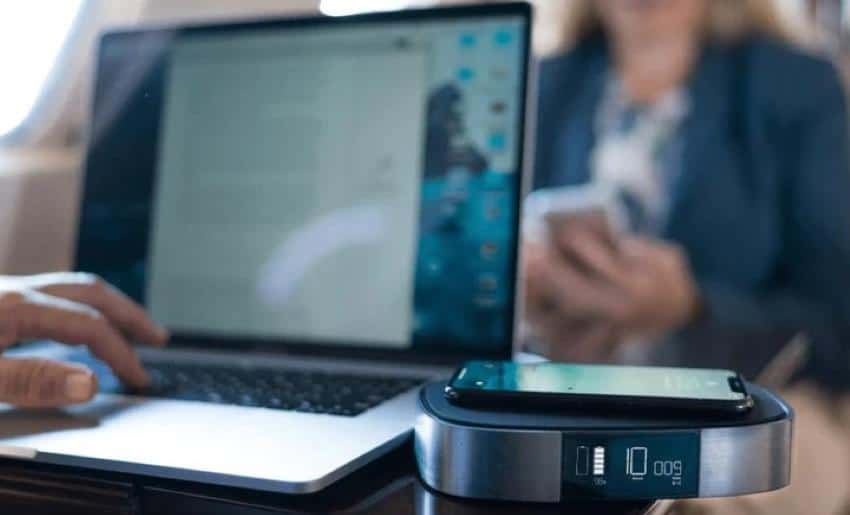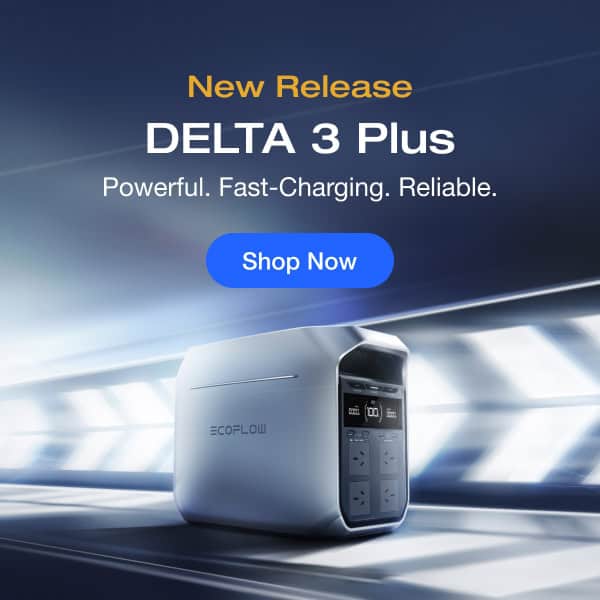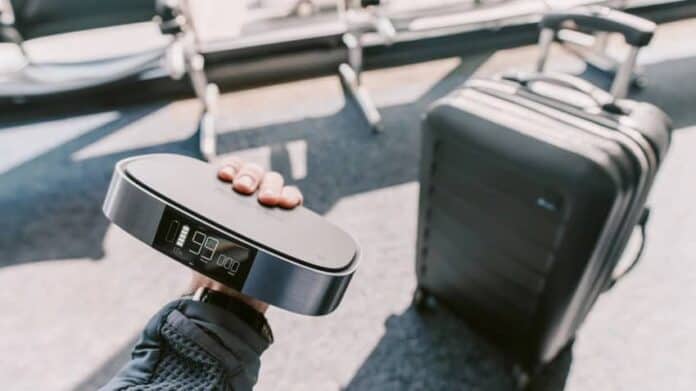There’s nothing worse than your phone dying mid-flight, especially when you need it for entertainment or travel plans. A power bank can be a lifesaver, but before packing one in your bag, you might ask: are power banks allowed on planes?
In fact, not all power banks are allowed, and there are specific limits on size, quantity, and where you can pack them. This guide covers everything you need to know, from watt-hour restrictions to checking your power bank’s capacity. Plus, there are a few handy tips to help you get through security hassle-free and keep your devices charged throughout your journey!
Can I Take a Power Bank on a Plane?
Yes, you can typically take a power bank on a plane, but there are important restrictions to consider. Most airlines let passengers carry power banks in their carry-on luggage, provided they meet specific capacity limits and quantity restrictions. The general rule is that flying with batteries with a capacity of 100 watt-hours (Wh) or less is permitted without special approval. However, it’s crucial to check with your specific airline and be aware of both international and domestic regulations, as they can vary slightly between different carriers and countries.
For travelers seeking a compact and efficient solution, the EcoFlow RAPID Magnetic Power Bank (5000mAh) is an excellent choice for air travel. It features Qi2-certified 15W wireless charging and a built-in 30W fast charging cable, allowing it to charge up to 70% in just 33 minutes. Additionally, this product is internationally certified and complies with airline regulations for carrying power banks, providing efficient and reliable power support throughout your journey.
Regulations for Carrying Power Banks on Airplanes
The regulations for carrying power banks on airplanes are designed to balance passenger convenience with safety concerns. Here’s a detailed breakdown of the rules:
1. Watt-Hour Limits
⦁ Power banks up to 100Wh: Allowed in carry-on baggage without airline approval.
⦁ Power banks between 100Wh and 160Wh: Allowed in carry-on baggage with airline approval.
⦁ Power banks over 160Wh: Prohibited on passenger aircraft.
2. Quantity Restrictions
⦁ For power banks up to 100Wh: No limit on the number you can carry.
⦁ For power banks between 100Wh and 160Wh: Maximum of two per passenger.
3. Placement
⦁ Power banks must be in carry-on baggage only.
⦁ They are not particularly allowed in checked luggage due to fire risk.
4. Condition
⦁ Power bank on plane must be for personal use only.
⦁ They should be in good condition without any signs of damage or defects.
5. Terminals Protection
⦁ The terminals of power banks should be protected to prevent short circuits.
⦁ This can be done by using the original packaging, taping over exposed terminals, or using separate plastic bags for each power bank.
6. Declaration
⦁ Passengers may need to declare power banks at security checkpoints.
⦁ Some airlines require pre-approval for power banks between 100Wh and 160Wh.
7. International Variations
While these regulations are generally consistent across countries, some may have slight variations. It’s advisable to carefully check with the specific airline and relevant aviation authorities when traveling internationally.
Table of Common Power Bank Capacities
Below is a table outlining common power bank capacities that are generally allowed on airplanes, helping you pack your devices without issues.
| Capacity (mAh) | Typical Voltage (V) | Watt-hours (Wh) | Allowed on Planes |
| 5,000 | 3.7 | 18.5 | Yes |
| 10,000 | 3.7 | 37 | Yes |
| 20,000 | 3.7 | 74 | Yes |
| 26,800 | 3.7 | 99.16 | Yes |
| 30,000 | 3.7 | 111 | With approval |
| 50,000 | 3.7 | 185 | No |
How Do You Determine Your Power Bank’s Capacity for Air Travel?
To determine your power bank’s capacity for air travel, you need to understand the difference between milliamp-hours (mAh) and watt-hours (Wh), as airlines use watt-hours for their restrictions. Here’s how to calculate the watt-hours of your power bank:
Locate the voltage (V) and capacity in milliamp-hours (mAh) on your power bank. These are typically printed on the device or in its documentation.
Convert mAh to Ah by dividing the mAh value by 1000.
Use the formula: Wh = V × Ah
For example, if your power bank is rated at 3.7V and 10,000mAh:
Convert 10,000mAh to 10Ah
Calculate: 3.7V × 10Ah = 37Wh
This 37Wh power bank would be allowed in carry-on luggage without special approval.
If you can’t find the voltage, most lithium-ion batteries in power banks use 3.7V. In this case, you can use a simplified calculation:
Wh ≈ mAh × 3.7 ÷ 1000
Remember that this calculation provides an approximation. If your power bank is close to the 100Wh limit, it’s best to contact the manufacturer for precise specifications or choose a lower-capacity option to ensure compliance with airline regulations.

Best Practices for Traveling with Power Banks
To maintain a smooth and safe journey with your portable power source, follow these handy tips:
1. Research Airline Policies: Before your trip, familiarize yourself with the mandatory policies of your airline regarding power banks. While most airlines follow similar guidelines, there can be slight variations, especially for power banks in the 100-160Wh range. Checking in advance can prevent last-minute issues at the airport and help you plan accordingly.
2. Protect Terminals: Safeguard your power bank’s terminals to prevent short circuits. You can do this by keeping the power bank in its original packaging, using a dedicated case, or carefully covering the terminals with electrical tape.
3. Keep Power Banks Easily Accessible: Store your power banks in an easily accessible part of your carry-on luggage. Doing so will allow for quick removal during security screenings if required, speeding up the process for you and other travelers.
4. Use Certified Products: Opt for power banks or portable power stations from reputable manufacturers that meet safety standards. Look for certifications like CE, FCC, or RoHS, which indicate compliance with various safety and quality regulations. Using certified products reduces the risk of malfunctions and increases the likelihood of hassle-free travel.
5. Charge Before Travel: Fully charge your power bank before your trip. This not only ensures you have maximum power available but also allows you to check that the power bank is functioning correctly.If you are in need of a high-capacity power bank on the road, EcoFlow RAPID Magnetic Power Bank (10000mAh) is a great choice. This model combines a robust 10,000mAh capacity with innovative rapid magnetic charging technology, ensuring that your devices remain powered up during long journeys. Its design meets stringent safety certifications, making it a reliable choice for frequent flyers seeking extra power on the go.
Conclusion
To conclude, the answer to “Can you take power banks on planes?” is a big yes! While you can generally take these devices on planes, it’s important to follow the regulations set by airlines and aviation authorities. Take note of the capacity limitations, pack your power banks properly in your carry-on luggage, and follow the best practices for their use to keep your devices charged throughout your air travel experience. Remember, when in doubt, always check with your airline for the most up-to-date information on carrying power banks on planes.
FAQ
Here are some commonly asked questions whether can you take power banks on planes.
Are power banks allowed in carry-on luggage?
Yes. Power banks or portable chargers containing lithium ion batteries must be packed in carry-on bags and cannot be placed in checked luggage due to the fire risks associated with lithium-ion batteries.
How many powerbanks can I bring on a plane?
You are allowed to bring multiple power banks on a plane in your carry-on luggage, as long as each battery has a capacity of 100 watt hours (Wh) or less. Passengers also have the option to carry up to two larger power banks with capacities between 101-160 watt hours with airline approval.
What is the largest power bank you can take on a plane?
The largest power bank you can safely take on a plane without airline approval is one with a capacity of 100 watt hours (Wh) or less. However, you may bring up to two larger lithium-ion batteries or power banks with capacities between 101-160 watt hours in your carry-on bags with airline approval.


